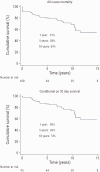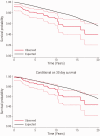Life expectancy after pulmonary endarterectomy for chronic thromboembolic pulmonary hypertension: a Swedish single-center study
- PMID: 32313643
- PMCID: PMC7158258
- DOI: 10.1177/2045894020918520
Life expectancy after pulmonary endarterectomy for chronic thromboembolic pulmonary hypertension: a Swedish single-center study
Abstract
Pulmonary endarterectomy is the guideline recommended treatment for chronic thromboembolic pulmonary hypertension, in addition to life-long anticoagulation therapy. The aim was to analyze long-term relative survival after pulmonary endarterectomy for chronic thromboembolic pulmonary hypertension. We included all patients who underwent pulmonary endarterectomy for chronic thromboembolic pulmonary hypertension at Karolinska University Hospital between 1997 and 2018 (n = 100). We obtained baseline characteristics and vital status from patient charts and national health-data registers. The expected survival from the general Swedish population matched by age, sex, and year of surgery was obtained from the Human Mortality Database. The relative survival was used as an estimate of cause-specific mortality. The mean age of the patients was 62 years and 39% were women. Most patients were severely symptomatic (95% in New York Heart Association functional class III-IV), and mean preoperative systolic/diastolic (mean) pulmonary artery pressure was 78/27 (45) mmHg. The mean and maximum follow-up time was 7.2 and 22.1 years, respectively. Early (30-day) mortality was 7%. The 15-year observed, expected, and relative survival was 55% (95% confidence interval, 40%-68%), 71%, and 77% (95% confidence interval, 56%-95%), respectively. The 15-year relative survival conditional on 30-day survival was 83% (95% confidence interval, 60%-100%). Although the life expectancy following pulmonary endarterectomy was shorter compared to the general population, the difference was small in those who survived the operation and the early postoperative period. Patients with chronic thromboembolic pulmonary hypertension who are surgical candidates should undergo pulmonary endarterectomy to improve prognosis.
Keywords: chronic thromboembolic pulmonary hypertension; life expectancy; pulmonary endarterectomy; survival.
© The Author(s) 2020.
Figures




References
-
- Becattini C, Agnelli G, Pesavento R, et al. Incidence of chronic thromboembolic pulmonary hypertension after a first episode of pulmonary embolism. Chest 2006; 130: 172–175. - PubMed
-
- Pengo V, Lensing AW, Prins MH, et al. Incidence of chronic thromboembolic pulmonary hypertension after pulmonary embolism. N Engl J Med 2004; 350: 2257–2264. - PubMed
-
- Ende-Verhaar YM, Cannegieter SC, Vonk Noordegraaf A, et al. Incidence of chronic thromboembolic pulmonary hypertension after acute pulmonary embolism: a contemporary view of the published literature. Eur Respir J 2017; 49: 1601792. - PubMed
-
- Svensk Förening för Pulmonell Hypertension. Svenska Pulmonell Arteriell Hypertension Registret – Årsrapport 2018, www.ucr.uu.se/spahr/arsrapporter/arsrapport-spahr-2018 (2019, accessed 30 March 2020).
LinkOut - more resources
Full Text Sources

